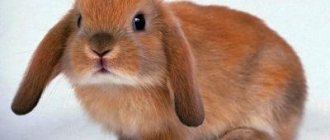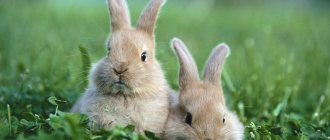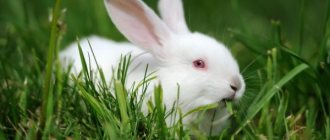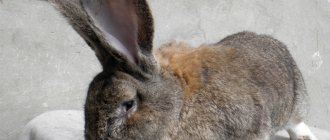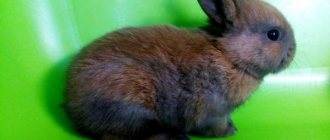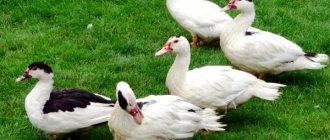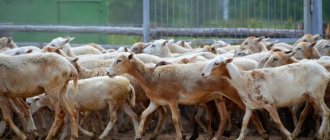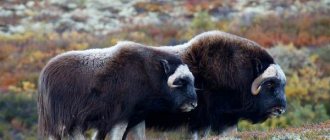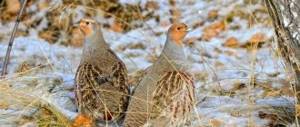History of Russian ermine rabbits
Chinese rabbit, Egyptian, African - they are all the same breed, which in our country is called Russian ermine. This breed has such a large number of names due to the fact that it wandered from one country to another. She originally came from the Himalayas, then moved to China, where rabbits of this breed were bred for sacrifice. Also, ermine rabbits are relatives of the Silver breed. They are called ermines because their fur is very similar to that of an ermine.
In Russia, the ermine rabbit has been known for a very long time, since the early 30s of the last century. Initially, the ancestors of Russian ermine rabbits appeared in Rus', which were brought here from Great Britain. These were small animals with amazingly shiny and beautiful fur, similar in appearance to ermine. The fur had a very thick undercoat. In total, there were approximately 22 thousand individual hairs per square centimeter of skin. Their body was 35-40 cm long, and their body weight was no more than 2.5 kg. They were imported for the purpose of obtaining dietary meat.
How to choose a good rabbit
When choosing a rabbit, you need to pay attention to its origin - whether it is a purebred or a crossbred. Then you should evaluate its exterior: what is the live weight and body size; how strong is his backbone; are the muscles well developed? Is his physique proportional and harmonious? After examining the rabbit as a whole, you need to carefully examine all parts of the body. A good rabbit should have a wide and deep chest - this is a sign of good health. The muscles should be firm to the touch, especially the lateral and lumbar muscles - evidence of meat formation. It is also necessary to check the thickness of the hair. To do this, on the ridge, sides and rump of the animal, you need to inflate the fur against the hair growth - the size of the bottom of the “rosette” will indicate the thickness of the fur and the condition of the skin.
A female rabbit with strong, rough bones, a rounded wide chest, an elastic, non-sagging belly with 8 nipples is considered a good individual, capable of bearing and feeding healthy offspring. A good male is one who has a massive and strong head and limbs, a wide chest, thick hair - i.e. The male type is expressed so clearly that it even visually distinguishes it from the female.
The often used clump index indicates the type of rabbit. The best indicator is 60 - 64: mesosomal type, characteristic of the meat-skin breed, to which the Russian ermine rabbit belongs. It is calculated as follows: divide the chest circumference behind the shoulder blades by the length and multiply by 100.
We also recommend reading:
The largest dog breeds What is domestication in animal husbandry Why you should get a cat: reasons voiced by scientists Euthanasia of animals
If the animal is of weak constitution, with loose skin and loose muscles, with any defects (underdevelopment of the limbs, skull bones, etc.), then it must be discarded: such a rabbit will have low live weight, poor-quality fur and will produce weak offspring.
Appearance of Russian ermine rabbits
This breed is quite miniature in size. Adult ermine rabbits usually weigh 4-5 kg. This figure was achieved through selection. They were crossed with larger breeds such as the White Giant.
The physique of this breed is very proportional - a small rounded head, a wide chest with a girth of 28-30 cm, a short and rather wide arched body, the length of which is a maximum of 52 cm. The constitution of the animal is quite strong. The ermine has a rounded croup and strong, straight legs. An ermine's ears always stand straight.
Russian ermine rabbits are similar in color to Siamese cats. They are mostly white except for the tail, paws, tips of the ears, and muzzle - these parts of their body are colored black or black-brown. Newborns are completely white in color; they acquire the color of adults when they reach six months of age. They have thick, elastic and shiny hair that looks and feels like a plush toy.
Bunny choice
To breed rabbits of this breed, you should not buy small rabbits, from which the quality of the breed is not yet visible, but healthy adults. First of all, you should evaluate the appearance of the animal, pay attention to the cleanliness of the fur and its shine. You cannot rely on your feelings - you need to weigh the rabbit. Then you need to feel it; strong muscles should be clearly felt on the sides and lower back; this is important, since the animal produces not only wool, but also meat. The paws should be strong, long, and not loose in the joints.
See also Features of fire rabbits
The quality of rabbit fur can be checked by lightly blowing on it against the direction of hair growth; the resulting hole should be deep and have smooth edges. In addition, this method will allow you to examine the rabbit’s skin to see if there are any sores or insect bites on it.
Females are slightly smaller than males, their skeleton is more rounded. There should be 8 nipples on the elastic belly; such a female will be able to bear and feed more than one offspring. The male is visually different from the female with a stronger and wider skeleton, muscle mass and even head. The correct choice of breeding rabbits is the key to success in breeding rabbit stock.
What to feed stoats?
This breed of rabbits is quite unpretentious in food. Any food of plant origin that is very rich in fiber will suit them. Also, despite their unpretentiousness, the diet should be as balanced as possible. It should include:
- B vitamins;
- all necessary minerals;
- fats;
- proteins;
- carbohydrates.
All this can be found in the following products: fishmeal, cereals, fresh green grass, succulent feed, animal feed and vegetables. Water must be present constantly and renewed every day.
Origin and history of the breed
The exact history of the origin of the breed has not been established. According to scientists, the first representatives of this species appeared before our era. In the 19th century, a breed of Himalayan rabbits was developed in Great Britain, which were brought to Russia 100 years later. Local breeders improved the breed.
However, later, due to crossing with other species, ermine rabbits were divided into two species. Moreover, in Europe another breed is being bred, which also belongs to this type of animal. Russian rabbits are inferior to Western ones in the quality of fur and meat. This is explained by the fact that breeders crossed this breed with a white giant. As a result, the animals' fur has lost its original thickness.
Maintenance of the Russian ermine breed
This breed of rabbit is suitable for breeding on amateur farms to obtain dietary meat and beautiful skins. They are unpretentious and hardy, and get along well in the climatic conditions of Russia. They do not require any additional personal care.
To keep these rabbits at home, you need a cage 60 or more centimeters long. In the summer, when it is hot outside, the cage should be placed in the shade, but there should be no draft in this place. But in winter, the animal must be kept in a room where the temperature will be at least 10 and no more than 25 degrees. If it is not possible to keep the rabbit's cage indoors, then the best solution is to cover it with a blanket. Also, this room should be well lit. Daylight hours for them should be approximately 12 hours a day.
To keep your animals looking tidy, you can bathe them periodically. Regular baby shampoo is best for this. After bathing, it is advisable to comb the coat using a special brush. If the care is high-quality and regular, the ermine skin will look like a very thick and dense head of hair.
Russian stoats are known for their fertility. A female of this breed can give birth to an average of 8-10 rabbits at a time. They are also good caring mothers who have enough milk for each baby rabbit, so the babies grow very quickly.
Maintenance and care
Keeping rabbits in cages is advantageous in that it is possible to ensure proper organization of their nutrition, reproduction, and treatment. To make a rabbit hutch, box containers, slabs, and construction waste are used. In order to save space, cages in the form of blocks of several pieces are installed on poles 70-80 cm high. The cage of an adult rabbit is at least 60 cm in length. The floors in it can be either slatted or mesh, but the nesting compartment is made only with a solid floor. A very convenient cage has a removable plastic tray. It is better to use a metal hanging feeder. The drinking bowl should also be made of metal - an automatic one is more convenient. Do not place rabbit hutches in a draft or near a heating device. If the time of year allows, then rabbits should be kept in the fresh air, without exposing them to direct sunlight. In winter, they should be in a warm room with a relative humidity of 60 - 75% and an air temperature of +10 to +25 degrees (C). The duration of room illumination is 10 - 16 hours, and the brightness should be moderate - approximately with a power of 40 V bulbs over an area of 10 m2.
Rabbits should be fed mainly plant food with sufficient fiber content. And if the rabbit is of good productivity, then unbalanced nutrition will compare the highly cultured breed with the lower, primitive one. The nutrition of the Russian ermine rabbit should cover the animal’s needs for proteins, carbohydrates, fat, vitamins, and minerals - the connection between the quality of food and the health of the rabbit is obvious. The diet of this breed includes alfalfa, clover, sainfoin and other green food; meat and bone and fish meal; various seeds and cereals; grass meal; succulent food in the form of green leaves.
To make a rabbit look well-groomed, it needs to be bathed (you can even use baby shampoo); if you use pet shampoo, it should be without a strong odor. The wool should be combed with a special metal fine-bristled brush with plastic balls at the end of the bristles. Thanks to careful combing, tangles will disappear. It is not necessary to cut your rabbit's hair - its fur renews itself, reaching the appropriate length for the breed.
For preventive purposes, rabbits should be systematically examined by a veterinarian, undergoing veterinary treatment (including vaccinations). The slightest suspicion of any disease is a signal to immediately call a veterinarian to establish a diagnosis and receive recommendations for treating the animal.
Proper maintenance, careful care and compassionate treatment are the key to ensuring that Russian ermine rabbits will be healthy and economically highly efficient.
Choosing a good ermine rabbit
The first and very important criterion in choosing an ermine rabbit is its physiological condition. Then attention should be paid to the animal's hair, it should be smooth and shiny, and the rabbit's ears should be clean, even and pointed upward. There should be no moisture near the eyes.
For slaughter, of course, it is better to choose a fatter individual. But an overweight rabbit will not be suitable for breeding, but this does not mean at all that it should be skinny.
If the animal meets all the above criteria, you can safely buy it.
Comments:
Expand comments
External characteristics
Ermine rabbits are recognized by their snow-white thick fur with short pile. Only the paws, ears and tail are painted black; there is a dark spot on the nose and near the mouth. The head of the animal is proportional to the body, the muzzle is elongated, the eyes are reddish-pink. The ears are short and erect, 12–13 cm long.
The body of adult ermine rabbits is 50–55 cm long, the back is arched. The legs are long, straight and strong. Males are always larger and slimmer than females, and their muscles are better developed. Rabbits are allowed to have belly fat, which is necessary during pregnancy. An adult ermine rabbit weighs 4 kg, the female is slightly less - 3.8 kg.
Himalayan
It is amazing how some of the oldest breeds have retained their uniqueness and remained unchanged to this day. Such rare lines include Silver, Danish rabbits and English Ram. The Himalayan is also from this series and it is so unique that it was even allocated to a separate category based on body type.
Blitz information
| Purpose: | universal |
| Size: | small, up to 2.5 kg |
| Color: | white with markings |
| Body type: | cylindrical |
| Fur type: | flyback |
| Temperament: | calm, friendly |
| Availability: | rare breed |
| Should a newbie start one? | Yes |
Characteristics
The Himalayan rabbit has an elongated, “snake-like” body. The shoulders and hips are in line, the legs are thin and long. The head is elongated, lean, with short, vertically set ears. The weight of an adult is 1.5-2.5 kg.
The exhibition rabbit is placed on the table lying down so that it stretches out as much as possible on its surface. If in most breeds the topline of the body should be rounded, then for this one it should be as even as possible. When viewed from above, the side lines should also run smoothly, without any special bulges, gradually expanding the ideal cylinder shape towards the back.
Flyback fur, with a characteristic white color for this breed with colored points and red eyes. Points include an egg-shaped spot on the nose, colored legs, ears and tail.
The markings can be black, chocolate, blue or purple, the main color being exclusively white.
The Himalayan color is also present in other breeds, in particular, the Mini Rex and the Netherland Dwarf. It is called Californian by Californians, Satins and Rexes, and White Pointed by Jersey Woolies, Rams and Angoras.
The color saturation can change depending on the air temperature - the colder it is, the darker the shade. In fact, a rabbit can develop a spot of color from prolonged contact with a cold surface, such as constant contact with a feeder on a winter night.
Temperament
The Himalayan is an elegant, beautiful rabbit, a representative of the smallest breed, not classified as a dwarf rabbit. Its small size and easy-going nature make it an excellent choice of pet for a child.
History of the breed
The breed appeared so long ago that the history of its origin is not known for certain. Some believe that it actually originated in the Himalayan mountains of the Middle East, but the truth is that reports of rabbits with this coloration have been appearing in different parts of the world for hundreds of years. They bore many names - Chinese, Egyptian, Russian ermines, Black-nosed.
Since the range of possible origins of the lineage is very wide, it is likely that this mutation occurred spontaneously in different regions. The variation that is presented today was obtained in Great Britain in the mid-19th century from rabbits brought from the Himalayas by English merchant travelers.
Unusual rabbits with high-quality smooth fur quickly became popular as a commercial and show breed. First there was a version with black points, then with blue, chocolate and, finally, with lilac.
0
Social buttons for Joomla
Rating 0.00 [0 Vote(s)]
Nuances of care and feeding
Experts recommend choosing cage housing for ermine rabbits. In the cold season, the cages are placed indoors so that the temperature is from +10°C to +25°C and the lighting is at least 12 hours a day. With the onset of warm weather, animals are moved outside, placing cages under canopies.
As for feeding, the diet of Russian ermines is no different from that of other breeds of rabbits. In the summer, dried green mass, seasonal vegetables and fruits are given.
It is recommended to select cellular content
Important point. Excessive feeding of vegetables leads to upset of the digestive system, and an abundance of beets, carrots and pumpkins gives the coat a brown tint.
With the onset of winter. Grass is replaced with high-quality hay, and silage, concentrates, and vitamin supplements are also provided. Don't forget about branch food. They are useful for rabbits in fresh and dried form.
Keeping and breeding rabbits
It is important to keep German Motley Giant rabbits in spacious cages or enclosures with a floor without metal mesh.
In the summer, it is advisable to walk in a specially built spacious enclosure. The pets' living area should be kept clean at all times. Although they can tolerate cold, inclement weather, they should avoid rooms where the wind blows.
The German giant rabbit breed does not tolerate darkness, but prolonged exposure to sunlight is unacceptable.
Before giving birth, females are placed in separate cages (preliminarily lined with straw). A soft, small-sized box is placed there. The rabbit herself will begin to build housing for the babies. You need to better monitor the individual’s diet, try not to touch or disturb it. The female is a very good mother (in practice, there are no known cases of a mother abandoning her baby). Due to the large amount of milk, the female rabbit has a 100% ability to feed all the rabbits.
Baby rabbits open their eyes only at 10-12 days. In the third week, they climb out of the nest on their own at night. It is recommended to separate babies from their mother in the second month. If you take rabbits from a female before the due date, then they may not gain weight well in the future, since this breed has a very close relationship between individuals.
After giving birth, the female needs constant access to drinking water. Otherwise (due to thirst) she may eat the rabbits.
Seminar on rabbit breeding. Examination of the German Motley Giant rabbit
German Spotted Giant (STROKACH)
Strokachi (German Spotted Giant) 100 days.
Diseases, prevention
To prevent diseases, it is necessary to vaccinate once every six months (vaccinations against VGBK and myxomatosis). If the manipulations are performed at the veterinarian, then you must take a document indicating the date and information about the vaccine.
If animals are kept in warm conditions, then the likelihood of catching a cold is very low. If this happens, then it is necessary to separate the sick individual from the healthy one in order to avoid infection of the entire population by airborne droplets.
Weight gain
Unlike other breeds of rabbits, the German Giant gains weight evenly every month. By the 3rd month he has a good weight of 2.3 kg, and by the fifth - 4.5 kg, which is very beneficial when breeding rabbits for meat. Usually eight-month-old individuals are taken for slaughter, but if they are kept longer than this period, they will continue to gain weight (but the meat in such cases becomes tougher).
Feeding
The diet of the eared animals in question should contain green plants, flower stems, dandelions, clover, and sedge. Do not deny your pet treats (they love fruits, vegetables, herbs (dill, sorrel, parsley)).
In the autumn-winter period, it is desirable to include vitamin-mineral complexes in food.
In winter, green feed is replaced with hay and straw. You can give the bark of fruit, coniferous and deciduous trees.
Recommended roughage:
- millet;
- corn;
- oats;
- rye;
- legumes
Advice: Change your drinking water more often, because it should always be fresh (this will reduce the likelihood of poisoning and transmission of diseases that can cause death).
Rabbits
Despite their superficial resemblance to hares, rabbits have several distinctive features.
Firstly, rabbits are born blind and naked, while hares are covered with hair from birth and are able to see. Secondly, they live mainly in underground burrows. They are somewhat smaller in size than hares. Another feature is that rabbits have been tamed and can now often be seen as pets.
More than 1000 years ago, the first attempts to breed the European rabbit (Oryctolagus cuniculus) were made in French monasteries; since then, rabbit breeding has taken many steps forward. Today there are more than 200 different breeds of domestic rabbits.
Domestic rabbits differ from their wild ancestors in the variety of sizes, colors, and coat structure. Dwarf rabbits can weigh less than 1 kg, individuals of large breeds of rabbits reach a weight of 10-11 kg. There are breeds bred for the purpose of producing meat and skins. At the same time, decorative rabbits are becoming more and more popular every day. They are convenient to keep in apartment conditions, like pets.
The most popular popular breeds of decorative rabbits:
The Himalayan rabbit is the oldest and one of the most popular breeds with a characteristic two-tone coloration and red eyes.
Himalayan rabbits weigh 1-2 kg.
The Dutch rabbit , developed in the 1830s in England, has a contrasting two-color pattern on its coat.
Weight: 2.0-2.3 kg.
Around the same time, in the Netherlands, as a result of crossing Dutch tortoiseshell rabbits and French harlequins, the Dutch tricolor rabbit
Weight: 1.7-2.5 kg.
As a result of the careful work of English breeders in the late 1850s, a breed was obtained - the Polish rabbit , which became the ancestor of all modern decorative breeds.
It is noteworthy that the dwarfism gene was not involved in its breeding
In the 20s of the 20th century, based on the Polish rabbit, German breeders developed an interesting breed, Hermelin , which gained popularity due to its toy appearance: miniature, short ears, rounded head shape.
, a colored dwarf rabbit was obtained from crossing a white hermelin with a rabbit of a different color , which, like the hermelin, weighed no more than 1.3 kg.
After the war, many color variations of this breed were bred.
In the mid-1980s, the Hotot , distinguished by its white color and black rim around the eyes, gained popularity among lovers of decorative rabbits.
In Belgium during these years, breeding work was carried out to breed the Angora dwarf rabbit , which won recognition for the quality of its wool.
Currently, standards divide the breed into several groups based on the length and quality of fur, weight and ear length.
Fox dwarf rabbit , often called dwarf fox. It is distinguished by smooth hair on the head and long hair throughout the body, as if covering it like a cloak.
Weight - within 1-1.5 kg. Colors: brown, chinchilla, agouti.
The Dwarf Rex , sometimes called the Teddy Rabbit, is a short-haired breed.
Externally, their fur resembles velvet or plush. If you run your hand over their coat, the hairs will return to their original position. They can weigh from 1.5 to 4 kg. By character they are usually phlegmatic and calm.
A special group of decorative rabbits are breeds with floppy ears, which give them a more pretty appearance. German breeders called them " rabbit-rams ".
This is the most popular breed for home keeping because they are less timid and quickly get used to people. It is believed that one of the reasons that they are not as shy is that their hearing is worse than that of rabbits with erect ears.
They are larger in weight than some other breeds of dwarf rabbits; their weight can reach up to 3 kilograms. Various colors: gray, white, black, blue and even yellow.
About the advantages of the breed
The main advantage of this breed is the presence of an elastic, dense, soft and shiny coat. The breed itself has the following positive aspects:
- presence of thick undercoat;
- guard hairs in large quantities;
- adaptability to Russian climatic conditions;
- the presence of excellent immunity;
- representatives of the breed are undemanding to living conditions and care;
- unpretentiousness to the food supply;
- excellent meat products with dietary properties.
